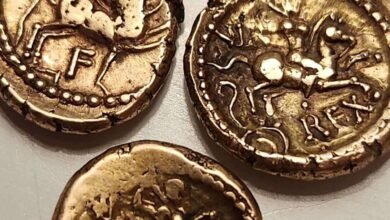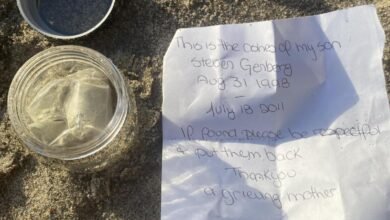Relics from Florida and finding new friends

Thom Parham has made it his mission to uncover parts of Florida’s buried past.
The 64-year-old history teacher and conventional archaeologist in Keystone Heights has set himself the goal of finding Seminole War Fort No. 11 – with the help of his metal detector.
The Seminole Wars began in 1817 and included three wars that lasted until 1858. They took place in Florida and remains of the battlefields and forts are still being excavated today.
Parham, who moved to Keystone Heights about six years ago, has been searching for remains of Seminole War Fort No. 11 ever since. He got lucky when Pete Wickham, a 77-year-old Keystone Heights resident, wrote to him about a coin he found on his property.
“They found what we call a diagnostic artifact, which is a silver coin from 1837, a half dime,” Parham said. “That date fits perfectly with the founding of the fort in 1838, a year later, and we know they paid the soldiers with those half dimes.”
Many say they do so-called metal detecting just for fun. But for Parham, it’s a means to an end.
“When you do urban archaeology like this, it can be very challenging, and a metal detector is not much help,” Parham said. “It only helps locate the actual site; the actual archaeology comes after that.”
Once Parham and his team find artifacts concentrated in a particular location, they begin searching for… garbage.
“If we’re really lucky, we’ll find one of their garbage pits, their garbage dump,” Parham said. “The material culture you find in the garbage dumps of a fort tells you a lot about who was there, what kind of soldiers they were and what their lives were like.”
Parham’s goal is to ultimately produce a site plan and report on Fort No. 11 for the Florida Department of Interior.
“With the evidence I present, they will create it in the master site file for archaeological sites in the state of Florida,” he said.
Parham, who donates most of his finds to museums, has already helped discover a Seminole War fortification in Middleburg: Fort Heilman.
He is not alone in his passion for metal detecting and history. Floridians from across the state come together and share a love of metal detecting.
Shane Greenway, a 52-year-old Ocala resident who helped start the Nature Coast Metal Detecting Group on Facebook, said the Florida metal detecting community is very supportive.
“Everyone works together to help each other. It’s not really a competition at all,” Greenway said. “It’s more of a community or Florida thing. Everyone here is pretty [in] a close-knit community.”
Metal detector clubs on Facebook exist throughout Florida and provide a forum for metal detectorists to discuss their finds, get tips and share their passion for the hobby, said Damien Wohlfert, 54. He has been a member of the Daytona Dig and Find Metal Detecting Club for 20 years.
“If you go to a coin or motorcycle club, you don’t get the family treatment you want. [in] “We are friends with everyone, like brothers and families. Everyone always helps out.”
53-year-old Gregg Papallo, founder of the Gainesville Metal Detecting Club, is now organizing community metal detector searches after a health scare.
“Honestly, I enjoy organizing the hunts because I had a stroke last March,” Papallo said. “After that, I was basically in rehab and learning to walk again. I haven’t really hunted since.”
“I like finding old things and it’s kind of interesting that you can dig up something that someone had in their hand over 115 to 25 years ago,” Greenway said. “Every once in a while it blows my mind when I dig up an old coin. If that coin could talk, that would just be very interesting to me.”
Papallo recalled the time when he made his most beautiful find while metal detecting on the grounds of Santa Fe College.
“I saw an American pin and then of course I went home and cleaned it. I realized it was a belt plate and I just thought, ‘Oh my goodness,'” Papallo said. “It was post-Civil War, because of the way it was made.”
Greenway, who has only been metal detecting for a little over a year, said his best finds were an 18-karat gold ring and a dime from 1908.
“There’s quite a lot, a lot of old stuff actually. You know, here in Florida we often find a lot of it, especially in the parks where there used to be old homesteads and stuff,” Greenway said. “You find shotgun shells and stuff like that from the late 1800s.”
Susan deFrance, an anthropology professor at the University of Florida and a zooarchaeologist, said that while the use of metal detectors is not common in archaeology, it can be helpful.
“If an amateur metal detecting worker finds coins or other material and works with a museum or something, that can be very helpful in locating or identifying an unknown site,” deFrance said. “So that’s certainly useful.”

However, not all detectorists stay on land.
Brandon Carmichael, a 41-year-old St. Petersburg resident, used to be more interested in finding historical objects than modern sunglasses and jewelry, he said. Today, he thrives on the beach.
“I kind of forced myself to do it and it took me a while to get used to it because it’s a lot different than searching on land,” Carmichael said. “But the more time I spent there, the more things I found and it was crazy.”
After finding a beach-dwelling family’s lost wedding ring, Carmichael started his own metal detecting group on Facebook called “Pinellas County Florida Ring Recovery” to help people find their lost items.
“I kind of realized, man, I can actually bring people a lot of joy by finding things they lost here,” Carmichael said.
Metal detecting on state lands and waters requires a permit from the Florida Department of State’s Division of Historic Resources. Without a permit, no person may begin metal detecting on state lands or waters.
Carmichael assembled a team of treasure hunters from across Pinellas County to help him locate lost items when he was unsuccessful.
“If I or my detective buddy are working, maybe other people in our group are retired or just have some free time or whatever,” he said. “Maybe they could go out and help someone before I get off at 5:30 or before my friend gets off.”
Carmichael said time is of the essence when searching for a lost item, especially on a Florida beach.
“It’s about getting there as quickly as possible because when something is in the water, the tides change, the currents change, the wind, even the wind alone can change things,” Carmichael said. “Everything has an impact on where things are and where they’re going.”
Wohlfert, who prefers beach searches to land-based searches, said there are many lost items for people to find on the beach.
“It’s a treasure hunt, and that’s all you find on the beaches,” Wohlfert said. “We find cell phones and keys, and we actually do a lot of searching for things for people who lose rings, diamond rings, you know, like their graduation rings on vacation.”
Carmichael said Florida’s beach climate isn’t the only challenge in finding a lost item.
“There are some people in our hobby that aren’t completely honest and I’ve found them or hung around on Facebook and social media in general,” Carmichael said. “They try to find posts where people say, ‘I lost something,’ only for them to go out and look for it first and not be able to return it, so it’s really disappointing.”
Parham said people seeking to profit in unethical ways can damage the community’s reputation.
“I consider the metal detector to be a tool of the more conventional archaeologists,” said Parham. “Because of these people, there has been a stigma attached to the use of metal detectors in the past.”
But for the most part, Greenway says, the community is mostly good.
“Everyone is very supportive and helps each other out,” Greenway said. “Whether it’s technical questions about the machines they operate, or whether it’s someone who has the same type of machine and has some tips and tricks.”
Carmichael said he can rely on the help of treasure hunters from across the state to find a lost item.
“We’ve been able to build a network between the east and west coasts of Florida,” Carmichael said. “I have friends on the east coast and friends in South Florida, so when I get stuck in different areas, I usually try to find out who lives in that area.”
Papallo said his favorite thing about his hobby is the metal detecting community in Florida.
“We are all like a family,” Papallo said. “We are all different ages, different backgrounds, different races. We all have one common goal: to save history before it is forgotten.”
Parham is still searching for relics from the Seminole War and said his drive to keep going is constantly renewed.
“About 80% of what you find is garbage, it’s junk, and that can be really discouraging if you don’t find anything for a long time,” Parham said. “But all you need is one really good artifact and you get the excitement and the motivation back, it’s that simple.”



